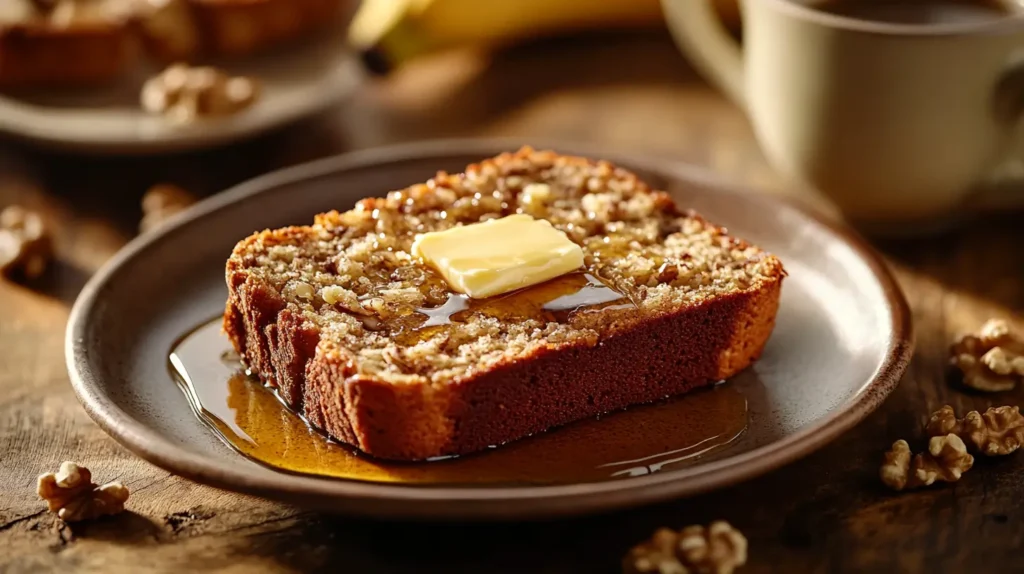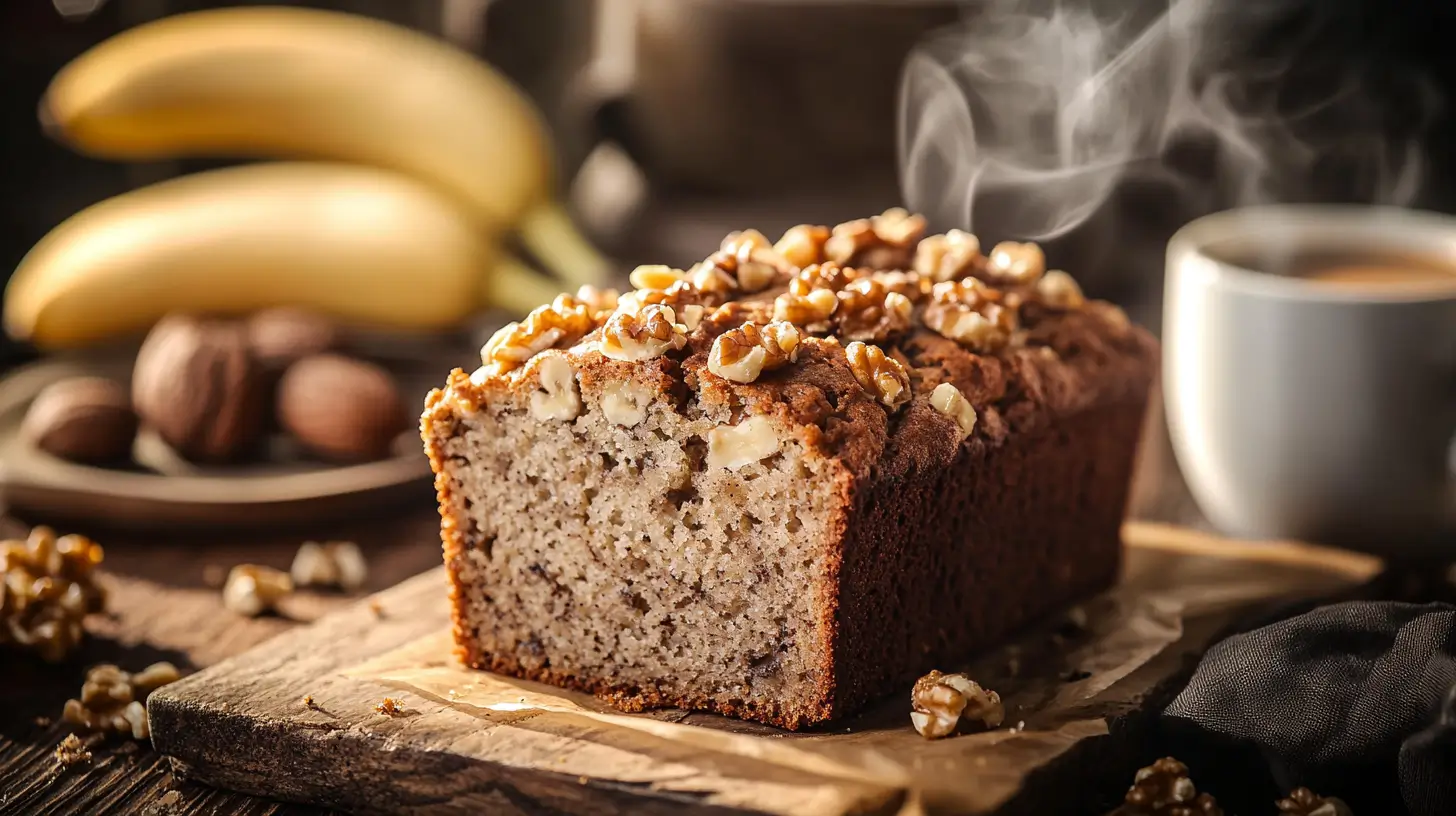Banana nut bread has been a beloved classic for generations. There’s something truly comforting about a warm slice of old-fashioned banana nut bread—its moist texture, rich banana flavor, and the perfect crunch from toasted nuts. Whether you’re baking it for a cozy weekend treat, a family gathering, or just to use up overripe bananas, this guide will help you make the most delicious loaf possible.
In this article, we’ll dive deep into everything you need to know about homemade banana nut bread. From its history and ingredients to step-by-step baking instructions, tips for keeping it moist, and creative variations, we’ve got you covered. You’ll also learn the best ways to store and serve your banana bread so it stays fresh and flavorful.
So, preheat that oven and grab your bananas—it’s time to bake the best old-fashioned banana nut bread you’ve ever tasted!
Table of Contents
1: Introduction to Old-Fashioned Banana Nut Bread
What is Old-Fashioned Banana Nut Bread?
Old-fashioned banana nut bread is a simple, rustic quick bread made with ripe bananas, chopped nuts (typically walnuts or pecans), butter, eggs, sugar, and flour. Unlike yeast-based breads, quick breads rise with baking soda or baking powder, making them soft, dense, and incredibly moist. This classic loaf is perfect as a breakfast treat, snack, or dessert.
The History and Origin of Banana Nut Bread
Banana bread first gained popularity in the 1930s during the Great Depression when home bakers sought creative ways to use overripe bananas instead of throwing them away. The availability of baking powder and baking soda made quick breads easier to bake, and soon, banana bread recipes started appearing in cookbooks. Over time, nuts were added for texture and flavor, leading to the beloved banana nut bread recipe we know today.
Why This Classic Recipe Stands the Test of Time
So, what makes old-fashioned banana nut bread so timeless? It’s incredibly easy to make, requires minimal ingredients, and always turns out delicious. The natural sweetness of bananas, combined with the crunch of nuts and the buttery richness, creates an irresistible combination. Plus, it’s a versatile recipe—whether you add chocolate chips, cinnamon, or even a streusel topping, this bread never disappoints.
Next up, we’ll explore the essential ingredients and substitutions to make your banana nut bread even better!
2: Ingredients and Substitutions for the Best Banana Nut Bread
Creating the perfect old-fashioned banana nut bread starts with using the best ingredients. While the classic recipe is simple, small changes can make a big difference in flavor and texture. Let’s break down the essential ingredients and some smart substitutions!

A collection of fresh ingredients used to bake moist banana nut bread
Essential Ingredients for a Traditional Banana Nut Bread
- Ripe Bananas – The riper, the better! Overripe bananas provide natural sweetness and moisture.
- All-Purpose Flour – This gives the bread structure. For a denser loaf, try whole wheat flour.
- Baking Soda & Baking Powder – These leavening agents help the bread rise.
- Eggs – They add richness and help bind the ingredients.
- Butter or Oil – Butter gives a richer flavor, while oil makes the bread extra moist.
- Sugar – Granulated sugar is standard, but brown sugar adds a caramel-like depth.
- Chopped Nuts – Walnuts and pecans are traditional choices, adding crunch and nuttiness.
Choosing the Best Bananas: Ripe vs. Overripe
Wondering if your bananas are too ripe? If they’re black-spotted and super soft, they’re perfect! Overripe bananas mash easily and blend smoothly into the batter, creating a moist banana nut bread with intense flavor.
Nut Selection: Walnuts, Pecans, or Almonds?
- Walnuts – The classic choice with a slightly bitter, earthy taste.
- Pecans – A sweeter, softer alternative that enhances the bread’s richness.
- Almonds – Less common but add a crunchy bite and mild sweetness.
Healthy Substitutions: Gluten-Free and Dairy-Free Options
- Swap all-purpose flour for almond or oat flour for a gluten-free version.
- Use coconut oil or applesauce instead of butter for a dairy-free loaf.
- Replace sugar with honey or maple syrup for a more natural sweetness.
Now that we’ve covered ingredients, let’s move on to the actual baking process!
3: Step-by-Step Guide to Making Old-Fashioned Banana Nut Bread
Making old-fashioned banana nut bread isn’t just about mixing ingredients—it’s about getting the perfect balance of moisture, fluffiness, and flavor. Follow this simple, step-by-step guide to baking the best banana nut bread ever!

A baker gently folding walnuts into banana bread batter for a perfect loaf
Prepping the Ingredients: Tips for a Perfect Mix
Before starting, gather all ingredients and let them reach room temperature. This ensures even mixing and better texture. Mash the bananas well, but leave a few small chunks for extra banana flavor. If using nuts, toast them lightly in a dry pan for a richer taste.
Combining Wet and Dry Ingredients: The Right Technique
- Mix Wet Ingredients – In a large bowl, beat butter (or oil) and sugar until creamy. Add eggs one at a time, followed by mashed bananas and vanilla extract.
- Whisk Dry Ingredients – In another bowl, whisk flour, baking soda, baking powder, and a pinch of salt.
- Combine Gently – Slowly fold the dry ingredients into the wet mixture. Avoid overmixing, or the bread will turn out dense!
- Add Nuts Last – Gently stir in chopped nuts, ensuring they’re evenly distributed.
How to Avoid Common Mistakes in Baking Banana Nut Bread
- Overmixing the batter – This leads to a tough, rubbery texture. Mix just until combined.
- Using unripe bananas – Less ripe bananas won’t add the same natural sweetness or moisture.
- Skipping the salt – A small amount enhances the overall flavor!
- Overbaking – Check for doneness at 50 minutes by inserting a toothpick—if it comes out clean, it’s ready.
Baking Time and Temperature: Ensuring a Perfect Texture
- Preheat oven to 350°F (175°C).
- Grease a 9×5-inch loaf pan or line it with parchment paper.
- Bake for 55-65 minutes or until golden brown and fully set.
- Let the bread cool in the pan for 10 minutes before transferring to a wire rack.
Want to experiment with unique banana bread flavors? Check out this delicious variation of banana bread for a tropical twist!
4: Tips and Tricks for Moist and Flavorful Banana Nut Bread
A great old-fashioned banana nut bread is all about the right texture—moist, soft, and rich in flavor. If your banana bread often turns out dry or bland, don’t worry! These expert tips will help you achieve the perfect loaf every time.
The Secret to Keeping Banana Bread Moist
- Use Overripe Bananas – The darker the peel, the better! Overripe bananas contain more natural sugars and moisture, resulting in a softer texture.
- Don’t Overmix the Batter – Overmixing develops gluten, making the bread tough instead of tender. Stir gently until the ingredients are just combined.
- Add a Moisture Booster – A splash of buttermilk, Greek yogurt, or sour cream enhances moisture and adds richness.
- Use Brown Sugar – It has more moisture than white sugar, giving the bread a soft crumb.
How to Enhance the Banana Flavor Naturally
- Mash Bananas Well – The smoother the mash, the better the distribution of banana flavor.
- Let the Batter Rest – Letting the batter sit for 10-15 minutes before baking can intensify the banana taste.
- Use Ripe Bananas Instead of Extracts – Artificial banana flavoring can taste overly sweet and unnatural. Stick to real bananas for the best flavor.
Adding a Crunchy Streusel Topping for Extra Flavor
A simple streusel topping can take your banana nut bread to the next level! Here’s a quick recipe:
- ¼ cup brown sugar
- 2 tbsp flour
- 2 tbsp cold butter, cubed
- ¼ cup chopped nuts
Mix everything until crumbly, then sprinkle over the batter before baking.
How to Make Your Banana Nut Bread More Nutty and Rich
- Toast Your Nuts – Lightly toasting walnuts or pecans enhances their natural oils and deepens the flavor.
- Mix in Almond Flour – Swapping a small portion of flour for almond flour adds extra richness.
- Add a Drizzle of Honey or Maple Syrup – This boosts sweetness and brings out the nutty flavors.
Now that you’ve mastered the perfect banana nut bread, let’s explore some fun variations!
5: Variations of Old-Fashioned Banana Nut Bread
Why stick to just one version of old-fashioned banana nut bread when you can get creative? Try these delicious variations to add a new twist to this classic recipe!
Chocolate Chip Banana Nut Bread: A Decadent Twist
Want to satisfy your sweet tooth? Add ½ cup of chocolate chips to the batter for a dessert-like treat. Dark chocolate pairs beautifully with the natural sweetness of bananas and the crunch of walnuts.
Healthy Banana Nut Bread with Whole Wheat Flour
For a healthier option, swap half of the all-purpose flour with whole wheat flour. This adds fiber while maintaining a soft texture. You can also use honey instead of sugar for a more natural sweetness.
Vegan and Eggless Banana Nut Bread Options
Making a plant-based version is easier than you think! Try these swaps:
- Flax Egg: Mix 1 tbsp ground flaxseed with 3 tbsp water to replace 1 egg.
- Coconut Oil or Applesauce: Use instead of butter for a dairy-free option.
- Almond Milk or Oat Milk: Instead of regular milk for extra moisture.
Adding Spices: Cinnamon, Nutmeg, and More
Spices can elevate your banana bread! Try these warm flavors:
- 1 tsp cinnamon – Adds warmth and depth.
- ½ tsp nutmeg – Enhances the banana’s natural sweetness.
- ¼ tsp cloves or allspice – For a hint of spice and richness.
For more delicious banana bread variations, check out this classic walnut banana bread recipe!
6: Storage and Serving Suggestions for Banana Nut Bread
Once you’ve baked the perfect old-fashioned banana nut bread, knowing how to store it properly ensures it stays fresh and delicious for days. Plus, serving it the right way can take your banana bread experience to the next level!

A warm slice of homemade banana nut bread, perfect with coffee
How to Store Banana Nut Bread to Keep It Fresh
- Room Temperature: Wrap the loaf in plastic wrap or place it in an airtight container. It stays fresh for up to 4 days at room temperature.
- Refrigeration: If you live in a humid area, store it in the fridge. Wrap it tightly to prevent it from drying out.
- Slice Only When Needed: Cutting the entire loaf exposes more surface area, causing it to dry out faster. Slice as needed!
Can You Freeze Banana Nut Bread? Best Practices for Freezing
Absolutely! Freezing is a great way to keep your banana nut bread fresh for up to 3 months. Follow these simple steps:
- Let the bread cool completely.
- Wrap it tightly in plastic wrap, then in aluminum foil.
- Place it in a freezer-safe bag.
- To thaw, leave it at room temperature for a few hours or warm slices in the microwave.
How to Reheat Banana Bread Without Drying It Out
For that fresh-out-of-the-oven taste, try these reheating methods:
- Microwave: Wrap a slice in a damp paper towel and heat for 15-20 seconds.
- Oven: Place in a 300°F (150°C) oven for 10 minutes.
Serving Ideas: Butter, Honey, or Cream Cheese?
Wondering how to serve your old-fashioned banana nut bread? Here are some delicious options:
- Classic: Spread with butter for a simple, rich flavor.
- Sweet Touch: Drizzle with honey or maple syrup for extra sweetness.
- Creamy Twist: Pair with cream cheese for a tangy contrast.
- Decadent Treat: Serve warm with a scoop of vanilla ice cream!
Now that you know how to store and serve your banana bread, let’s answer some common questions!
7: Frequently Asked Questions
Got questions about making the perfect old-fashioned banana nut bread? Here are answers to some of the most commonly asked questions!
1. How do you make banana nut bread moist and fluffy?
To keep banana nut bread moist, use overripe bananas, brown sugar, and a moisture booster like yogurt, sour cream, or buttermilk. Also, avoid overmixing the batter—stir just until combined!
2. Can I use frozen bananas for banana nut bread?
Yes! Frozen bananas work great in banana bread. Just let them thaw completely and drain any excess liquid before mashing. They often have an even stronger banana flavor!
3. Why did my banana nut bread turn out dense?
Dense banana bread is often caused by overmixing the batter or using too much flour. Make sure to measure flour correctly using the spoon-and-level method and stir gently to avoid overworking the gluten.
4. What is the best way to ripen bananas quickly for baking?
Need ripe bananas in a hurry? Try these tricks:
- Oven Method: Bake unpeeled bananas at 300°F (150°C) for 15-20 minutes.
- Paper Bag Method: Place bananas in a paper bag with an apple to speed up the ripening process overnight.
8: Conclusion
There’s a reason old-fashioned banana nut bread has stood the test of time—it’s simple to make, incredibly delicious, and endlessly versatile. Whether you’re baking it as a comforting treat, a quick breakfast, or a thoughtful homemade gift, this classic recipe never disappoints.
By choosing the right ingredients, following proper mixing techniques, and using the best storage methods, you can ensure your banana bread turns out perfectly moist and flavorful every time. Plus, with fun variations like chocolate chip banana bread or a crunchy streusel topping, there’s always a new way to enjoy this beloved recipe.
So, the next time you have overripe bananas sitting on your counter, don’t throw them away—turn them into a warm, nutty, and satisfying loaf of old-fashioned banana nut bread! Happy baking!
What is your opinion about this recipe: The Ultimate Guide to Making Chicken Bacon Ranch Tater Tot Casserole
Print
Old-Fashioned Banana Nut Bread – A Foolproof Recipe You’ll Love
- Total Time: 1 hour 10 minutes
- Yield: 1 loaf (8-10 slices)
- Diet: Vegetarian
Description
This old-fashioned banana nut bread is a moist, buttery, and nutty classic that’s easy to make and packed with rich banana flavor. Perfect for breakfast, a snack, or a comforting treat, this foolproof recipe ensures a soft, flavorful loaf every time. With simple ingredients and a step-by-step guide, you’ll bake the most delicious banana nut bread that tastes just like grandma’s!
Ingredients
- 3 large overripe bananas, mashed
- ½ cup (1 stick) unsalted butter, melted
- ¾ cup granulated sugar (or substitute brown sugar for extra moisture)
- 2 large eggs, room temperature
- 1 tsp vanilla extract
- ¼ cup buttermilk (or Greek yogurt for extra moisture)
Dry Ingredients:
- 2 cups all-purpose flour
- 1 tsp baking soda
- ½ tsp baking powder
- ½ tsp salt
- 1 tsp cinnamon (optional, but adds warmth)
Add-Ins:
- ¾ cup chopped walnuts or pecans (toasted for extra flavor)
- ½ cup chocolate chips (optional, for a sweet twist)
Instructions
Step 1: Prep Your Ingredients
- Preheat your oven to 350°F (175°C). Grease a 9×5-inch loaf pan or line it with parchment paper.
- In a medium bowl, mash the bananas until smooth.
Step 2: Mix the Wet Ingredients
- In a large mixing bowl, whisk together the melted butter and sugar.
- Add eggs, one at a time, beating well after each addition. Stir in the vanilla extract and buttermilk.
- Mix in the mashed bananas until fully incorporated.
Step 3: Combine Dry Ingredients
- In a separate bowl, whisk together the flour, baking soda, baking powder, salt, and cinnamon.
Step 4: Mix the Batter
- Gradually fold the dry ingredients into the wet ingredients, mixing gently until just combined. Do not overmix!
- Fold in the chopped nuts (and chocolate chips, if using).
Step 5: Bake the Banana Nut Bread
- Pour the batter into the prepared loaf pan and smooth the top.
- Bake for 55-65 minutes, or until a toothpick inserted in the center comes out clean.
- Let the bread cool in the pan for 10 minutes, then transfer to a wire rack to cool completely.
Notes
- For extra moisture, replace half of the butter with unsweetened applesauce.
- To ripen bananas quickly, place them in a 300°F (150°C) oven for 15 minutes.
- Store leftovers in an airtight container at room temperature for 4 days or freeze for up to 3 months.
- Prep Time: 10 minutes
- Cook Time: 55-65 minutes
- Category: Breakfast
- Method: Baking
- Cuisine: American

